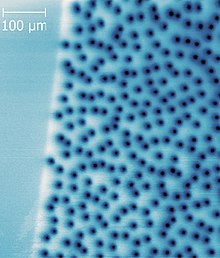Abrikosov vortex

In superconductivity, a fluxon (also called an Abrikosov vortex or quantum vortex) is a vortex of supercurrent in a type-II superconductor, used by Alexei Abrikosov to explain magnetic behavior of type-II superconductors.[2] Abrikosov vortices occur generically in the Ginzburg–Landau theory of superconductivity.
Overview
[edit]The solution is a combination of fluxon solution by Fritz London,[3][4] combined with a concept of core of quantum vortex by Lars Onsager.[5][6]
In the quantum vortex, supercurrent circulates around the normal (i.e. non-superconducting) core of the vortex. The core has a size — the superconducting coherence length (parameter of a Ginzburg–Landau theory). The supercurrents decay on the distance about (London penetration depth) from the core. Note that in type-II superconductors . The circulating supercurrents induce magnetic fields with the total flux equal to a single flux quantum . Therefore, an Abrikosov vortex is often called a fluxon.
The magnetic field distribution of a single vortex far from its core can be described by the same equation as in the London's fluxoid [3] [4]
where is a zeroth-order Bessel function. Note that, according to the above formula, at the magnetic field , i.e. logarithmically diverges. In reality, for the field is simply given by
where κ = λ/ξ is known as the Ginzburg–Landau parameter, which must be in type-II superconductors.
Abrikosov vortices can be trapped in a type-II superconductor by chance, on defects, etc. Even if initially type-II superconductor contains no vortices, and one applies a magnetic field larger than the lower critical field (but smaller than the upper critical field ), the field penetrates into superconductor in terms of Abrikosov vortices. Each vortex obeys London's magnetic flux quantization and carries one quantum of magnetic flux .[3][4] Abrikosov vortices form a lattice, usually triangular, with the average vortex density (flux density) approximately equal to the externally applied magnetic field. As with other lattices, defects may form as dislocations.
See also
[edit]References
[edit]- ^ Wells, Frederick S.; Pan, Alexey V.; Wang, X. Renshaw; Fedoseev, Sergey A.; Hilgenkamp, Hans (2015). "Analysis of low-field isotropic vortex glass containing vortex groups in YBa2Cu3O7−x thin films visualized by scanning SQUID microscopy". Scientific Reports. 5: 8677. arXiv:1807.06746. Bibcode:2015NatSR...5E8677W. doi:10.1038/srep08677. PMC 4345321. PMID 25728772.
- ^ Abrikosov, A. A. (1957). "The magnetic properties of superconducting alloys". Journal of Physics and Chemistry of Solids. 2 (3): 199–208. Bibcode:1957JPCS....2..199A. doi:10.1016/0022-3697(57)90083-5.
- ^ a b c London, F. (1948-09-01). "On the Problem of the Molecular Theory of Superconductivity". Physical Review. 74 (5): 562–573. Bibcode:1948PhRv...74..562L. doi:10.1103/PhysRev.74.562.
- ^ a b c London, Fritz (1961). Superfluids (2nd ed.). New York, NY: Dover.
- ^ Onsager, L. (March 1949). "Statistical hydrodynamics". Il Nuovo Cimento. 6 (S2): 279–287. Bibcode:1949NCim....6S.279O. doi:10.1007/BF02780991. ISSN 0029-6341. S2CID 186224016.
- ^ Feynman, R.P. (1955), Chapter II Application of Quantum Mechanics to Liquid Helium, Progress in Low Temperature Physics, vol. 1, Elsevier, pp. 17–53, doi:10.1016/s0079-6417(08)60077-3, ISBN 978-0-444-53307-4, retrieved 2021-04-11
- ^ de Gennes, Pierre-Gilles (2018) [1965]. Superconductivity of Metals and Alloys. Addison Wesley Publishing Company, Inc. p. 59. ISBN 978-0-7382-0101-6.














